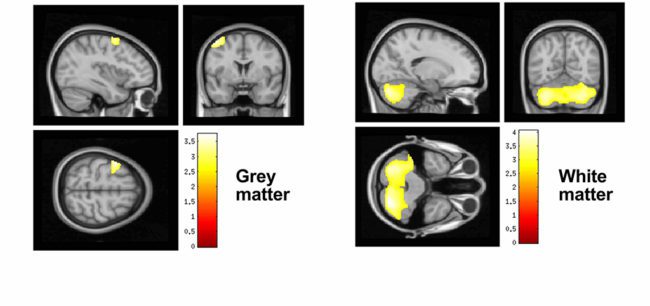BACKGROUND:
Proponents of the biophilia hypothesis believe that contact with nature, including green spaces, has a crucial role in brain development in children. Currently, however, we are not aware of evidence linking such exposure with potential effects on brain structure.
OBJECTIVE:
We determined whether lifelong exposure to residential surrounding greenness is associated with regional differences in brain volume based on 3-dimensional magnetic resonance imaging (3D MRI) among children attending primary school.
METHODS:
We performed a series of analyses using data from a subcohort of 253 Barcelona schoolchildren from the Brain Development and Air Pollution Ultrafine Particles in School Children (BREATHE) project. We averaged satellite-based normalized difference vegetation index (NDVI) across 100-m buffers around all residential addresses since birth to estimate each participant’s lifelong exposure to residential surrounding greenness, and we used high-resolution 3D MRIs of brain anatomy to identify regional differences in voxel-wise brain volume associated with greenness exposure. In addition, we performed a supporting substudy to identify regional differences in brain volume associated with measures of working memory (d′ from computerized n-back tests) and inattentiveness (hit reaction time standard error from the Attentional Network Task instrument) that were repeated four times over one year. We also performed a second supporting substudy to determine whether peak voxel tissue volumes in brain regions associated with residential greenness predicted cognitive function test scores.
RESULTS:
Lifelong exposure to greenness was positively associated with gray matter volume in the left and right prefrontal cortex and in the left premotor cortex and with white matter volume in the right prefrontal region, in the left premotor region, and in both cerebellar hemispheres. Some of these regions partly overlapped with regions associated with cognitive test scores (prefrontal cortex and cerebellar and premotor white matter), and peak volumes in these regions predicted better working memory and reduced inattentiveness.
CONCLUSION:
Our findings from a study population of urban schoolchildren in Barcelona require confirmation, but they suggest that being raised in greener neighborhoods may have beneficial effects on brain development and cognitive function.
Read the Research
References:
- Bowler D, Buyung-Ali L, Knight T, Pullin A. 2010. A systematic review of evidence for the added benefits to health of exposure to natural environments. BMC Public Health10:456, PMID: 20684754, doi:10.1186/1471-2458-10-456. Crossref, Medline, Google Scholar
- Conners CK, Multi-Health Systems Staff. 2000. Conners’ Continuous Performance Test II: Computer Program for Windows Technical Guide and Software Manual. North Tonwanda, NY:Multi-Health Systems. Google Scholar
- Dadvand P, Nieuwenhuijsen MJ, Esnaola M, Forns J, Basagaña X, Alvarez-Pedrerol M. 2015a. Green spaces and cognitive development in primary schoolchildren. Proc Natl Acad Sci U S A112(26):7937–7942, PMID: 26080420, doi:10.1073/pnas.1503402112. Crossref, Medline, Google Scholar
- Dadvand P, Rivas I, Basagaña X, Alvarez-Pedrerol M, Su J, De Castro Pascual M, 2015b. The association between greenness and traffic-related air pollution at schools. Sci Total Environ523:59–63, PMID: 25862991, doi:10.1016/j.scitotenv.2015.03.103. Crossref, Medline, Google Scholar
- Dadvand P, Sunyer J, Basagaña X, Ballester F, Lertxundi A, Fernández-Somoano A, 2012. Surrounding greenness and pregnancy outcomes in four Spanish birth cohorts. Environ Health Perspect120(10):1481–1487, PMID: 22899599, doi:10.1289/ehp.1205244. Link, Google Scholar
- Dadvand P, Wright J, Martinez D, Basagaña X, McEachan RRC, Cirach M, 2014. Inequality, green spaces, and pregnant women: roles of ethnicity and individual and neighbourhood socioeconomic status. Environ Int71:101–108, PMID: 24997306, doi:10.1016/j.envint.2014.06.010. Crossref, Medline, Google Scholar
- Escobedo FJ, Kroeger T, Wagner JE. 2011. Urban forests and pollution mitigation: Analyzing ecosystem services and disservices. Environ Pollut159(8–9):2078–2087, PMID: 21316130, doi:10.1016/j.envpol.2011.01.010. Crossref, Medline, Google Scholar
- Fedewa AL, Ahn S. 2011. The effects of physical activity and physical fitness on children’s achievement and cognitive outcomes. Res Q Exerc Sport82(3):521–535, PMID: 21957711, doi:10.1080/02701367.2011.10599785. Crossref, Medline, Google Scholar
- FIL (Functional Imaging Laboratory) Methods Group (and Honorary Members). 2013. SPM8 Manual. http://www.fil.ion.ucl.ac.uk/spm/doc/spm8_manual.pdf [accessed 26 June 2017]. Google Scholar
- Forns J, Esnaola M, López-Vicente M, Suades-González E, Alvarez-Pedrerol M, Julvez J, 2014. The n-back test and the attentional network task as measures of child neuropsychological development in epidemiological studies. Neuropsychology28(4):519–529, PMID: 24819069, doi:10.1037/neu0000085. Crossref, Medline, Google Scholar
- Friedman LA, Rapoport JL. 2015. Brain development in ADHD. Curr Opin Neurobiol30:106–111, PMID: 25500059, doi:10.1016/j.conb.2014.11.007. Crossref, Medline, Google Scholar
- Gidlöf-Gunnarsson A, Öhrström E. 2007. Noise and well-being in urban residential environments: the potential role of perceived availability to nearby green areas. Landsc Urban Plan83(2):115–126, doi:10.1016/j.landurbplan.2007.03.003. Crossref, Google Scholar
- Grandjean P, Landrigan PJ. 2014. Neurobehavioural effects of developmental toxicity. Lancet Neurol13(3):330–338, PMID: 24556010, doi:10.1016/S1474-4422(13)70278-3. Crossref, Medline, Google Scholar
- Jaeggi SM, Buschkuehl M, Perrig WJ, Meier B. 2010. The concurrent validity of the N-back task as a working memory measure. Memory18(4):394–412, PMID: 20408039, doi:10.1080/09658211003702171. Crossref, Medline, Google Scholar
- James P, Banay RF, Hart JE, Laden F. 2015. A review of the health benefits of greenness. Curr Epidemiol Rep2(2):131–142, PMID: 26185745, doi:10.1007/s40471-015-0043-7. Crossref, Medline, Google Scholar
- Kahn PH. 1997. Developmental psychology and the biophilia hypothesis: children’s affiliation with nature. Dev Rev17(1):1–61, doi:10.1006/drev.1996.0430. Crossref, Google Scholar
- Kahn PH, Kellert SR. 2002. Children and Nature: Psychological, Sociocultural, and Evolutionary Investigations. Cambridge, MA:MIT Press. Crossref, Google Scholar
- Kellert SR. 2005. Building for Life: Designing and Understanding the Human-Nature Connection. Washington, DC: Island Press. Google Scholar
- Kellert SR, Wilson EO. 1993. The Biophilia Hypothesis. Washington, DC:Island Press. Google Scholar
- Klatte M, Bergström K, Lachmann T. 2013. Does noise affect learning? A short review on noise effects on cognitive performance in children. Front Psychol4:578, PMID: 24009598, doi:10.3389/fpsyg.2013.00578. Crossref, Medline, Google Scholar
- Owen AM, McMillan KM, Laird AR, Bullmore E. 2005. N-back working memory paradigm: a meta-analysis of normative functional neuroimaging studies. Hum Brain Mapp25(1):46–59, PMID: 15846822, doi:10.1002/hbm.20131. Crossref, Medline, Google Scholar
- Pujol J, Fenoll R, Macià D, Martínez-Vilavella G, Alvarez-Pedrerol M, Rivas I. 2016a. Airborne copper exposure in school environments associated with poorer motor performance and altered basal ganglia. Brain Behav6(6):e00467, PMID: 27134768, doi:10.1002/brb3.467. Crossref, Medline, Google Scholar
- Pujol J, Martínez-Vilavella G, Macià D, Fenoll R, Alvarez-Pedrerol M, Rivas I, 2016b. Traffic pollution exposure is associated with altered brain connectivity in school children. NeuroImage129:175–184, PMID: 26825441, doi:10.1016/j.neuroimage.2016.01.036. Crossref, Medline, Google Scholar
- Rook GA. 2013. Regulation of the immune system by biodiversity from the natural environment: an ecosystem service essential to health. Proc Natl Acad Sci U S A110(46):18360–18367, PMID: 24154724, doi:10.1073/pnas.1313731110. Crossref, Medline, Google Scholar
- Rueda MR, Fan J, McCandliss BD, Halparin JD, Gruber DB, Lercari LP, 2004. Development of attentional networks in childhood. Neuropsychologia42(8):1029–1040, PMID: 15093142, doi:10.1016/j.neuropsychologia.2003.12.012. Crossref, Medline, Google Scholar
- Rueda MR, Rothbart MK, McCandliss BD, Saccomanno L, Posner MI. 2005. Training, maturation, and genetic influences on the development of executive attention. Proc Natl Acad Sci U S A102(41):14931–14936, PMID: 16192352, doi:10.1073/pnas.0506897102. Crossref, Medline, Google Scholar
- Shelton JT, Elliott EM, Matthews RA, Hill BD, Gouvier WD. 2010. The relationships of working memory, secondary memory, and general fluid intelligence: working memory is special. J Exp Psychol Learn Mem Cogn36(3):813–820, PMID: 20438278, doi:10.1037/a0019046. Crossref, Medline, Google Scholar
- Song X-W, Dong Z-Y, Long X-Y, Li S-F, Zuo X-N, Zhu C-Z, 2011. REST: A toolkit for resting-state functional magnetic resonance imaging data processing. PLoS One6(9):e25031, PMID: 21949842, doi:10.1371/journal.pone.0025031. Crossref, Medline, Google Scholar
- Spanish Ministry of Public Works. 2012. Atlas de la Vulnerabilidad Urbana en España 2001 y 2011: Metodología, contenidos y créditos (Edición de diciembre de 2015) [in Spanish]. http://www.fomento.gob.es/NR/rdonlyres/40668D5E-26B6-4720-867F-286BD55E1C6B/135960/20160201METODOLOGIAATLASVULNERABILIDAD2001Y2011.pdf [accessed 27 May 2016]. Google Scholar
- Stoodley CJ, Valera EM, Schmahmann JD. 2012. Functional topography of the cerebellum for motor and cognitive tasks: an fMRI study. NeuroImage59(2):1560–1570, PMID: 21907811, doi:10.1016/j.neuroimage.2011.08.065. Crossref, Medline, Google Scholar
- Sunyer J, Esnaola M, Alvarez-Pedrerol M, Forns J, Rivas I, López-Vicente M, 2015. Association between Traffic-related air pollution in schools and cognitive development in primary school children: a prospective cohort study. PLoS Med12(3):e1001792, PMID: 25734425, doi:10.1371/journal.pmed.1001792. Crossref, Medline, Google Scholar
- UN Department of Economic and Social Affairs. 2015. World Urbanization Prospects: The 2014 Revision. New York, NY:United Nations. Google Scholar
- USGS (U.S. Geological Survey). 2015. NDVI, the foundation for remote sensing phenology. https://phenology.cr.usgs.gov/ndvi_foundation.php [accessed 21 July 2017]. Google Scholar
- Wilson EO. 1984. Biophilia. Cambridge, MA:Harvard University Press. Google Scholar

